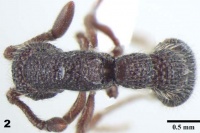Parasyscia browni
| Parasyscia browni | |
|---|---|

| |
| Scientific classification | |
| Kingdom: | Animalia |
| Phylum: | Arthropoda |
| Class: | Insecta |
| Order: | Hymenoptera |
| Family: | Formicidae |
| Subfamily: | Dorylinae |
| Genus: | Parasyscia |
| Species: | P. browni |
| Binomial name | |
| Parasyscia browni (Bharti & Wachkoo, 2013) | |
This species seems to be rare in Shivalik range of Northwest Himalaya and only a single specimen was found in a single locality of a reserved forest area (Rajaji Forest Area), in Uttarakhand during intensive surveys. This species was found in leaf litter, along the edge of a primary, subtropical, semi-evergreen forest with a good annual precipitation.
Identification
Bharti & Akbar (2013) - C. browni is the third member of doheryti group from India with Parasyscia aitkenii Forel, 1900 and Parasyscia indica Brown, 1975 known previously. It differs considerably from all previously known species. It may be distinguished from C. aitkenii by black color (unicolorous), rugo-reticulate sculpture and strongly constricted cintus of gaster, with 1st gastral tergite much broader than postpetiole whereas C. aitkenii is bi-colored, foveate and 1st gastral tergite is as broad as postpetiole. C. indicus is reddish brown, foveate, petiole is longer than broad and head subtriangular while as petiole is broader than long and head is rectangular in C. browni.
Keys including this Species
Distribution
Latitudinal Distribution Pattern
Latitudinal Range: 30.2483° to 30.2483°.
| North Temperate |
North Subtropical |
Tropical | South Subtropical |
South Temperate |
- Source: AntMaps
Distribution based on Regional Taxon Lists
Oriental Region: India (type locality).
Distribution based on AntMaps
Distribution based on AntWeb specimens
Check data from AntWeb
Countries Occupied
| Number of countries occupied by this species based on AntWiki Regional Taxon Lists. In general, fewer countries occupied indicates a narrower range, while more countries indicates a more widespread species. |

|
Estimated Abundance
| Relative abundance based on number of AntMaps records per species (this species within the purple bar). Fewer records (to the left) indicates a less abundant/encountered species while more records (to the right) indicates more abundant/encountered species. |

|
Biology
Castes
Known only from the worker caste.
Nomenclature
The following information is derived from Barry Bolton's Online Catalogue of the Ants of the World.
- browni. Cerapachys browni Bharti & Wachkoo, 2013d: 1189, figs. 1-3 (w.) INDIA (Uttarakhand).
- Type-material: holotype worker.
- Type-locality: India: Uttarakhand, Rajaji Forest Area, 30.2483°N, 77.9878°E, 660 m., 12.viii.2009, hand picking (A.A. Wachkoo).
- Type-depository: PUAC.
- Combination in Parasyscia: Borowiec, M.L. 2016: 204.
- Status as species: Bharti, Guénard, et al. 2016: 21.
- Distribution: India.
Unless otherwise noted the text for the remainder of this section is reported from the publication that includes the original description.
Description
Worker
TL 4.78; HL 1.00; HW 0.83; EL 0.18; WL 1.26; PL1 0.48; PW1 0.56; PL2 0.60; PW2 0.66; SL 0.65; GL 1.44. Indices: CI 83; SI 78; PI 116 (n = 1).
Head. Rectangular, slightly longer than broad, sides gently convex; vertex shallowly concave. Mandibles subtriangular, dentate. Antennae 12 segmented; scapes short and clavate, reaching up to 4/5th of posterior margin of head; apical funicular segment longest (0.57 mm), almost the length of scape. Eyes moderate, round, not protruded, placed at the middle of head; ocelli absent. Posterior 1/3rd of head ventrally excavated giving temple a lobulated shape in lateral view. Anterior clypeal margin entire and convex; posterior margin deflexed and flat.
Mesosoma. Wider posteriorly; dorsal profile slightly convex; sutures absent. Propodeal declivity truncate; anterior border of pronotum and propodeal angle marginate.
Metasoma. Petiole dorsally subrectangular, broader than long with sides diverging posteriorly; anterior face straight; dorsal profile convex. Subpetiolar process large, directed posteriorly, located beneath anterior 1/3rd of the petiole; fenestra oval. Postpetiole broader than long. Gaster elongate; base of first gastral tergite with cross ribs.
Sculpture. Head, petiole and postpetiole uniformly rugo-reticulate, reticular interspaces shiny. Mesosoma similarly rugo-reticulate; metanotum and mesopleuron medially with a smooth patch; reticulations on metanotum, mesopleuron and sternite of postpetiole graded into an area of isolated foveae separated by shiny interspaces. Gaster foveate; foveae of anterior 1/4th of 1st gatral tergite are coarsest and densest, posteriorly foveae become progressively smaller and more scattered; foveae on remaining gastral tergites are confined to posterior 1/2 leaving anterior 1/2 smooth and shiny. Cinctus of 1st gastral tergite microreticulate. Scapes covered with dense foveolae; mandibles and legs with similar but scattered foveolae.
Vestiture. Whole body covered with moderate suberect pilosity; apical funicular segments pubescent.
Color. Black with mandibles, antennae and legs castaneous.
Type Material
- Holotype, worker (missing left hind leg), Uttarakhand, Rajaji Forest Area, 660 m a.s.l., India, 30°14′54″N 77°59′16″E / 30.2483°N 77.9878°E, 12.viii.2009, A.A. Wachkoo; hand picking.
Etymology
The species is named in honor of William L. Brown, Jr.
References
- Aswaj, P., Sahanashree, R., Udayakantha, W.S., Aniruddha, M., Priyadarsanan, D.R. 2021. Two new species of doryline ants (Hymenoptera, Formicidae) with 11-segmented antennae from India. ZooKeys 1056, 59–72 (doi:10.3897/zookeys.1056.68722).
- Bharti, H. & Wachkoo, A.A. 2013. Cerapachys browni and Cerapachys costatus, two new rare ant species (Hymenoptera: Formicidae) from India. Biologia 68/6: 1189—1192 (doi:10.2478/s11756-013-0260-9).
- Borowiec, M.L. 2016. Generic revision of the ant subfamily Dorylinae (Hymenoptera, Formicidae). ZooKeys 608: 1-280 (doi: 10.3897/zookeys.608.9427).
- Chen, Z., Liang, C., Du, C. 2022. Revision of Chinese species of the ant genus Parasyscia Emery, 1882 (Hymenoptera: Formicidae: Dorylinae). Zootaxa 5196(3), 301–330 (doi:10.11646/zootaxa.5196.3.1).

